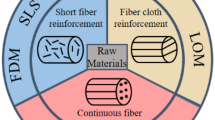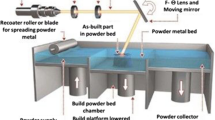Abstract
Being light weight and superior in characteristics, hybrid materials such as fiber metal laminate (FMLs) and functionally graded structures (FGS) are becoming increasingly popular in aeronautical, automobile and military industries. In the present work, an innovative methodology which hereafter will be named as “3A method” has been proposed to replace complex shaped, monolithic, metallic sheet parts with hybrid parts. This method is based on simultaneous forming of any number of multiple metallic blanks in required shape by applying hydroforming (HF) technology. Based on numerical simulations, forming limit diagrams (FLDs) are established for three types of blanks forming hemispherical shaped parts using Barlat 2000 yield criteria/DYNA Form/LS Dyna. To validate the simulation results, experimental study is accomplished and optimal process parameters are determined by varying the cavity pressure under constant die-binder gap. Effects of number of layers and thickness of blanks on thinning, wrinkling and punch force have been well studied for three types of blanks and a comparative analysis is made to investigate various failure modes. To achieve a composite layered structure, post forming procedure has been devised and implemented to get a final hybrid part. Furthermore, limitations of the 3A method in terms of final shape of parts are discussed. Good agreement can be found between numerical and experimental research. The new methodology is capable of employing any types of resins and composite materials at any required place in parts for desired characteristics. Elimination of repeated heating and solidification of blank assembly as well as precise punch force and speed requirements make this multilayer blank forming method more efficient, economical and user friendly for manufacturing of FMLs and FGSs at commercial scales.














Similar content being viewed by others
References
Zhang SH (1991) Developments in hydroforming. J Mater Process Technol 91:236–244
Kocańda A, Sadłowska H (2008) “Automotive component development by means of hydroforming”. Arch Civil Mech Eng 8(No 3)
Sinmazçelik T, Avcu E, Özgür Bora M, Coban O (2011) A review: fibre metal laminates, background, bonding types and applied test methods, materials and design. Mater Des 32:3671–3685
Botelho EC, Silva RA, Pardini LC, Rezende MC (2006) A review on the development and properties of continuous fiber/epoxy/aluminum hybrid composites for aircraft structures. Mater Res 9(3):247–256
Vogelesang LB, Schijve J (1995) Fibre metal laminates: damage tolerant aerospace materials. Case Stud Manuf Adv Mater 2:259–260
Takamatsu T, Matsumura T, Ogura N, Shimokawa T, Kakuta Y (1999) Fatigue crack growth properties of a GLARE3-5/4 fiber/metal laminate. Eng Fract Mech 63:253–272
Carrillo JG, Cantwell WJ (2009) Mechanical properties of a novel fiber—metal laminate based on a polypropylene composite. Mech Mater 41:828–838
Takamatsu T, Shimokawa T, Matsumura T, Miyoshi Y, Tanabe Y (2003) Evaluation of fatigue crack growth behavior of GLARE3 fiber/metal laminates using a compliance method. Eng Fract Mech 70:2603–2616
Homan JJ (2006) Fatigue initiation in fibre metal laminates. Int J Fatigue 28:366–374
Long AC (2007) “Composite forming technologies”. Woodhead Publishing Limited and CRC Press LLC, ISBN-13: 978-1-84569-033-5, pp. 207
Park SY, Choi WJ, Choi HS (2010) A comparative study on the properties of GLARE laminates cured by autoclave and autoclave consolidation followed by oven postcuring. Int J Adv Manuf Technol 49:605–613
Kumar KV, Safiullah M, Ahmad ANK (2013) Root cause analysis of heating rate deviations in autoclave curing of CFRP structures. Int J Innov Res Stud 2(Issue 5):369–378
Dmitriev O, Mischenko S (2011) “Optimization of curing cycles for thick-wall products of the polymeric composite materials”. Advances in Composite Materials - Ecodesign and Analysis, ISBN 978-953-307-150-3, pp. 141–160.
Abdullah MR, Cantwell WJ (2012) The high-velocity impact response of thermoplastic—matrix fibre—metal laminates. J Strain Anal 47(Issue 7):432–443
Mosse L, Compston P, Cantwell W, Cardew-Hall M, Kalyanasundaram S (2005) Effect of process temperature on the formability of fibre—metal laminates. Compos Part A 36:1158–1166
Mossea L, Compstona P, Cantwell WJ, Cardew-Hall M, Kalyanasundaram S (2006) Stamp forming of polypropylene based fibre—metal laminates: the effect of process variables on formability. J Mater Process Technol 172:163–168
Huang SF, Huang K-J (2002) Stamp forming of locally heated thermoplastic composites. Compos Part A 33:669–676
Kalyanasundaram S, DharMalingam S, Venkatesan S, Sexton A (2013) Effect of process parameters during forming of self reinforced—PP based fiber metal laminate. Compos Struct 97:332–337
Hou M (1997) Stamp forming of continuous glass fibre reinforced polypropylene. Compos Part A 28A:695–702
Wojciechowski S (2000) New trends in the development of mechanical engineering materials. J Mater Process Technol 106:230–235
Yoshida Y, Urabe M, Hino R, Toropov VV (2003) Inverse approach to identification of material parameters of cyclic elasto-plasticity for component layers of a bimetallic sheet. Intern J Plast 19:2149–2170
Yuen WYD (1996) A generalised solution for the prediction of spring- back in laminated strip. J Mater Process Technol 61:254–264
Wlosinski W, Olesinska W, Pietrzak K (1996) Bonding of alumina to steel using copper interlayer. J Mater Process Technol 56:190–199
Lang L, Danckert J, Nielsen KB (2005) Multi-layer sheet hydroforming: Experimental and numerical investigation into the very thin layer in the middle. J Mater Process Technol 170:524–535
Yoshida F (1997) Deformation and fracture of sheet metal laminates in plastic forming. Proceedings of 4th international conference on composite engineering, 61–64
Hwang YM, Hsu HH, Lee HJ (1995) Analysis of sandwich sheet rolling by stream function method. Int J Mech Sci 37(3):297–315
Takuda H, Fujimoto H, Hatta N (1998) Formabilities of steel/aluminium alloy laminated composite sheets. J Mater Sci 33:91–97
Takuda H, Hatta N (1998) “Numerical Analysis of the Formability of an Aluminum 2024 Alloy Sheet and Its Laminates with Steel Sheets”. Metall Mater Trans A, 29A: 1998–2829
Morovvati MR, Fatemi A, Sadighi M (2011) Experimental and finite element investigation on wrinkling of circular single layer and two-layer sheet metals in deep drawing process. Int J Adv Manuf Technol 54:113–121
Aghchai AJ, Shakeri M, Mollaei-Dariani B (2008) Theoretical and experimental formability study of two-layer metallic sheet (Al1100/St12). Proc Inst Mech Eng B J Eng Manuf 222:1131
Keeler SP (1965) Determination of forming limits in automotive stampings. Sheet Met Ind 42:683–691
Goodwin GM (1968) Application of strain analysis to sheet metal forming problems in the press shop. Metall Ital 60:764–774
Sowerby R, Duncan JL (1971) Failure in sheet metal in biaxial tension. Int J Mech Sci 13:217–229
Djavanroodi F, Derogar A (2010) Experimental and numerical evaluation of forming limit diagram for Ti6Al4V titanium and Al6061-T6 aluminium alloys sheets. Mater Des 31:4866–4875
Rezaee-Bazzaz A, Noori H, Mahmudi R (2011) Calculation of forming limit diagrams using Hill’s 1993 yield criterion. Int J Mech Sci 53(4):262–270
Percy JH, Brown RH (1980) The effect of strain rate on the forming limit diagram for sheet metal. CIRP Ann Technol 29(1):151–152
Jie M, Cheng CH, Chan LC et al (2009) Forming limit diagrams of strain-rate-dependent sheet metals. Int J Mech Sci 51(4):269–275
Lee YS, Kwon YN, Kang SH et al (2008) Forming limit of AZ31 alloy sheet and strain rate on warm sheet metal forming. J Mater Process Technol 201(1–3):431–435
Palumbo G, Sorgente D, Tricarico L (2010) A numerical and experimental investigation of AZ31 formability at elevated temperatures using a constant strain rate test. Mater Des 31:1308–1316
Wilson DV, Mirshams AR, Roberts WT (1983) An experimental study of the effect of sheet thickness and grain size on limit-strains in biaxial stretching. Int J Mech Sci 25(12):859–870
Stachowicz F (1989) Effects of microstructure on the mechanical properties and limit strains in uniaxial and biaxial stretching. J Mech Work Technol 19:305–317
Narayanasamy R, SathiyaNarayanan C (2008) Forming, fracture and wrinkling limit diagram for if steel sheets of different thickness. Mater Des 29(7):1467–1475
Kleemola HJ, Kumpulainen JO (1980) Factors influencing the forming limit diagram: part II—influence of sheet thickness. J Mech Work Technol 3(3–4):303–311
Zadpoor AA, Sinke J, Benedictus R (2009) The effects of thickness on the formability of 2000 and 7000 series high strength aluminum alloys. Key Eng Mater 410–411:459–466
Marciniak Z, Kuczynski K (1967) Limit strains in the processes of stretch-forming sheet. Int J Mech Sci 9(9):609–620
Zafar R, Lihui L, Rongjing Z, Shaohua W (2014) “Formability analysis of fiber metal laminates using rubber sheet and forming techniques”. Proc Int Bhurban Conf Appl Sci Technol (IBCAST) 44–47
Acknowledgments
For successful completion of this work, the authors wish to acknowledge the financial support providedby the International Scientific Cooperation Project (2010DFA52030) and National Science Foundation of China(51175024).
Author information
Authors and Affiliations
Corresponding author
Rights and permissions
About this article
Cite this article
Zafar, R., Lang, L. & Zhang, R. Experimental and numerical evaluation of multilayer sheet forming process parameters for light weight structures using innovative methodology. Int J Mater Form 9, 35–47 (2016). https://doi.org/10.1007/s12289-014-1198-3
Received:
Accepted:
Published:
Issue Date:
DOI: https://doi.org/10.1007/s12289-014-1198-3




